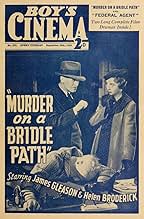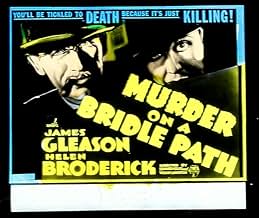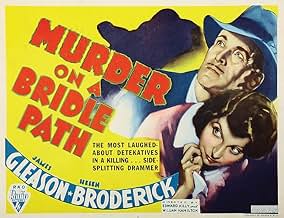Adicionar um enredo no seu idiomaAfter Hildegarde proves that the accidental riding death on a Central Park bridle path is really murder, she's faced with a plethora of red herrings and a real killer.After Hildegarde proves that the accidental riding death on a Central Park bridle path is really murder, she's faced with a plethora of red herrings and a real killer.After Hildegarde proves that the accidental riding death on a Central Park bridle path is really murder, she's faced with a plethora of red herrings and a real killer.
- Direção
- Roteiristas
- Artistas
- Taxi Driver
- (não creditado)
- Pipe Expert
- (não creditado)
Avaliações em destaque
The film starts with a blonde lady being disagreeable with several folks--a clear giveaway that she'll soon be murdered (it's a standard cliché in mystery films of the time). VERY soon after, she's killed while out riding her horse. Again, Calvinnme was right--this character wasn't developed enough and her death came too quickly. The police assume she died by accident but soon they notice a few clues that indicate she was NOT killed by being kicked by a horse. Around this time, Hildegarde shows up and immediately begins digging for clues. Like any murder mystery of the era, there are lots of dead ends and twists--along with a VERY florid ending involving the murderer--and it's by far the best part of the movie.
This is a pretty good mystery film. Unfortunately, the snappy dialog from Withers isn't as obvious--not just due to Broderick but because the writing is a bit less snappy. Enjoyable but that's really about all.
This is, indeed, the fourth murder case on which Miss Withers assists, critiques, leads, follows, and just generally offers suggestions to her crusty detective friend. James Gleason's Oscar Piper is once again easily chagrined but grudgingly respectful of Miss Withers' detecting skills; Helen Broderick takes on the role of school teacher and amateur sleuth Hildegarde Withers for the first and only time. This Withers is a bit less tart and somewhat more conscious of her own wittiness than the earlier Withers (as portrayed by Edna May Oliver). Broderick and Gleason quickly establish a rapport and relationship that—as in the earlier films in the series—is easily our primary reason for watching.
The plot involves the death of society girl Violet Feveral, played (albeit briefly) with delicious nastiness by Sheila Terry. Suspects abound—this Violet was, in the best whodunit tradition, wildly unpopular and had handed out insults and injuries to numerous other characters in the hours and days before her death. The familiar faces in the lineup of suspects include Louise Latimer as a sister to the victim; John Carroll as a family employee; and Leslie Fenton, who is quite good as the nervous ex-husband who has just been mysteriously released from jail. Willie Best stands out in his usual thankless role as a stable boy who may have a clue or two; his deadpan delivery when answering questions (What was he doing in jail? "Shooting craps." No, what was he in jail for? "Shooting craps.") squeezes the maximum out of a role that's otherwise a lame stereotype.
The mystery itself is not particularly inventive or suspenseful; however, the story moves along briskly and the actors and script are competent if not brilliant. The interaction between Gleason and Broderick is clearly presented as the center of the picture—and that relationship between a couple of pros is a lot of fun to watch. (One example: Oscar suggests that the murder was a "crime of passion," to which Hildegarde snaps, "Oscar, don't you think we'd better try to keep this case clean?")
Bonus: we are instructed what can be learned about a person from examining his pipe!
In this entry in the series, a pretty but difficult young woman makes enemies of everyone around her, although we're told about this more than we see it - the girl barely gets more than a scene before she is murdered while riding her horse one morning. Only the homicide investigation turns up the most likely suspect - a rich ex-husband who was a husband in the first place only because the murdered woman wanted a big payoff in the form of alimony. Piper thinks he's on to something until he learns that the man in question was in jail for non payment of alimony at the time, and that the man's only close living relative, his father, who also hates the girl for what she has done to his son, is an invalid incapable of traipsing around parks early in the morning. There are other numerous less likely suspects introduced just to keep you guessing.
As usual, Hildegarde out-sleuths Piper at several key junctures, but she also makes a key miscalculation that leads up to a big joke at her expense in the last scene, after the mystery is solved. The fact that this one word - applesauce - could ever have been considered a curse word of sorts may seem strange to modern audiences. Stranger still was that the production code was so sensitive at the time that the film had to make the retort to Hildegarde appear to have two meanings.
This one is an above average mystery and well acted, just don't expect the magic of the ones with both Gleason and Oliver starring.
** (out of 4)
The fourth film in RKO's Hildegarde Withers series was the first after Edna May Oliver stepped away from the part and was replaced by Helen Broderick for the first and only time. In the film a society woman is out riding her horse when she's thrown from it and then murdered. Detective Piper (James Gleason) thinks it's a simple case of her being killed by the fall but Withers comes across the scene and notices that the woman was murdered after the fall. The two team up to track down the usual suspects. MURDER ON A BRIDLE PATH isn't as bad as its reputation but at the same time there's no question that it's a major fall from the previous three movies. There's no doubt that Broderick isn't nearly as good as Edna May Oliver but she isn't too bad here. I thought she was decent for what was being asked as she has no problem playing the smart woman and she at least makes us believe she's a lot smarter than Piper for what that's worth. As usual Gleason is very good in his part as the rather slow Detective who is always one step behind the lady. While both actors do a fine job, the same can't be said with their comic timing and chemistry. I think what really hurts the movie is the fact that the two don't share the same spark as in the previous three films. The screenplay isn't the greatest thing either because there's never any clear case of who the killer is and when he's revealed it really seems like a stretch. As is the case in most weaker written mysteries, the police and Withers would have never found out had the killer not given himself away and of course breaking to the point where he tells everything. In the end this film is pretty much on par with the majority of "B" mysteries that were released throughout the decade but at the same time it also makes you appreciate the first three films for how special they were.
Você sabia?
- CuriosidadesAlthough this is the first and only time Helen Broderick played Hildegarde Withers in the six picture series, James Gleason played Inspector Oscar Piper in all of them.
- Erros de gravaçãoWhen Hildegard is looking through the telescope, the field of view follows the horse running around the track, yet she doesn't move the telescope.
- Citações
Hildegarde Withers: How long have you worked around here?
'High-Pockets': About three months, Ma'am... not countin' the week I was in jail.
Hildegarde Withers: What were you doing in jail?
'High-Pockets': Shootin' craps.
Hildegarde Withers: No, I mean what did they put you in jail for?
'High-Pockets': Shootin' craps.
- ConexõesFollowed by O Enigma da Pérola (1936)
Principais escolhas
Detalhes
- Data de lançamento
- País de origem
- Idioma
- Também conhecido como
- Murder on a Bridle Path
- Locações de filme
- Empresa de produção
- Consulte mais créditos da empresa na IMDbPro
- Tempo de duração1 hora 6 minutos
- Cor
- Proporção
- 1.37 : 1
Contribua para esta página

































